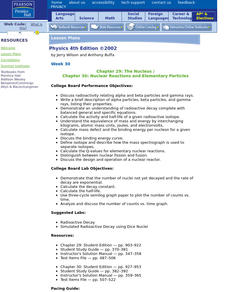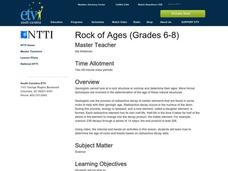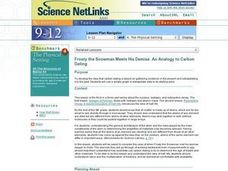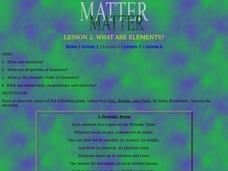Virginia Department of Education
Radioactive Decay and Half-Life
Explain the importance of radioactive half-life as your high school biologists demonstrate the concept by performing a series of steps designed to simulate radioactive decay. Pupils use pennies to perform an experiment and gather data....
Curated OER
Radioactivity Experiments
Students study the difference between types of ionizing radiation and how elements are transmuted. They determine that radiation is normal and surrounds us. They calculate the amounts of alpha, beta and gamma radiation emitted from a...
Curated OER
The Nucleus / Nuclear Reactions and Elementary Particles
Students describe how radioactivity relates to alpha and beta particles. Using their properties, they write a descriptive paper about the gamma rays and alpha and beta particles. They calculate q-values and the half-life of a given...
Curated OER
Radioactive Decay: A Sweet Simulation of a Half-life
Students demonstrate rates of decay of unstable nuclei can be measured. They understand ratios and multiplication of fractions. They simulate radioactive decay. They read about the accomplishments of scientists.
Curated OER
Rock of Ages
Students use a video, the Internet and hands-on activities to explore how to determine the age of rocks and fossils based on radioactive decay data.
Curated OER
Frosty the Snowman Meets His Demise: An Analogy to Carbon Dating
Students read and discuss an article about carbon dating, then participate in a hands-on lab to discover how carbon dating works. Students also write a letter to a friend explaining the process, and how archeologists use the process to...
Curated OER
SURVIVING A COSMIC INVASION
Pupils read periodicals relating to radioacitivity and interpret a Geiger Counter. They work in small groups, share information and help each other explain the Geiger Counter. They discover the relationship distance to bombardment/contact.
Curated OER
Properties of Matter
Ninth graders explore the molecular structure of matter and how it can affect the physical characteristics of a specific material. They demonstrate that isotopes of an element have different masses. Students demonstrate that the rates of...
Curated OER
Exponential Decay
Students study exponential decay and its application to radiocarbon dating. In this exponential decay lesson, students use candy to model the time it takes for something to decay. Students also graph the data they collect and describe...
Curated OER
Electron Sqare Dance
Students participate in an Electron Square Dance in which they act the part of atoms. They follow the structure of different atoms suggested by the teacher.
Curated OER
How does Nuclear Fission differ from Nuclear Fusion?
Young scholars examine concepts of nuclear chemistry. They compare and contrast the topics of nuclear fission and nuclear fision. They predict the outcome of reactions based on the types of emissions and reactants.
Curated OER
What Are Elements?
Students investigate elements by by defining scientific terms. In this Periodic Table of Elements instructional activity, students utilize a glass of water, and powdered fruit drink to perform a lab activity demonstrating properties of...
Curated OER
What is Radon?
Students read an article about radon and its properties. They examine a periodic table and identify the numbers surrounding an element. They discuss the harmful and helpful effects of radiation.
Curated OER
Splitting the Atom
Students use the Internet to research the history of the splitting of the atom. They use that research to prepare a presentation on an aspect of that topic. A map is generated to record findings and results.















